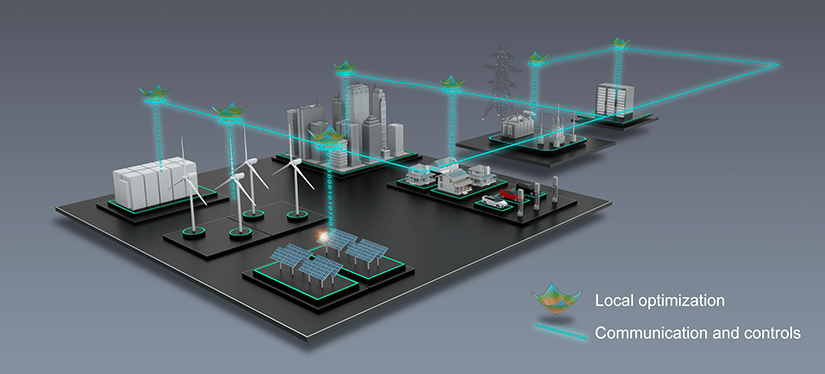OptGrid Controls Distributed Energy Resources for Grid Optimization
OptGrid autonomously optimizes power flow between devices, helping new energy resources work for the grid and the grid work for energy resources.
OptGrid manages energy from the bottom up, using a distributed rather than centralized approach to control devices. This shift brings real-time management to the grid edge, where devices can be leveraged for flexibility, recovery, and energy savings.
Functionality
OptGrid has been created and tested to manage distributed energy resources (DERs) to their full potential for grid efficiency and resilience. OptGrid solves real-time optimal power flow problems at the grid edge, where it is installed on common devices like smart meters and inverters. OptGrid coordinates the optimized devices so that collectively, DERs are used to balance supply and demand, support grid reliability, and reduce the impact of outage events.
With OptGrid, the power grid can be reconfigured into a patchwork of microgrids, capable of islanding and self-optimizing, or supporting the broader grid. OptGrid advances the vision of autonomous energy grids by providing the controls that can be applied at any scale for fast and automatic management for a modern energy system with greater amounts of renewable resources.

On real systems, OptGrid is an all-in-one solution for the ongoing growth in DERs and renewables. With real-time distributed intelligence of devices on the power system, OptGrid can match the variable supply of assets like wind turbines and solar panels to the variable demand of residents and businesses. Its generality and adaptability allow OptGrid to optimize any number of devices—over 1 million in-lab simulations to-date—with the same high level of performance.
Features
In the face of integration challenges for millions of new energy devices on the grid, OptGrid presents a new architecture that facilitates the flexibility required by the grid, at a time scale that is relevant for real-time operations. OptGrid improves operations in the following four categories.
Resilience
- Maximizes use of local resources, eliminating dependence on far-away generation
- Provides autonomous operation in islanded mode, and facilitates automatic islanding and reconnecting
- Coordinates DERs for blackstart
- Creates flexible microgrid boundaries, such that local generation can rapidly best serve the highest needs loads
Efficiency
- Controls power hardware at sub-second timescales, relevant for frequency and voltage regulation
- Optimizes devices behind the meter in coordination with devices beyond the meter
- Can be customized for application development, whether for utility operations or home energy management
- Provides an engine to serve transactive energy markets with real-time power exchange
Integration
- Boosts integration of new technology by ensuring devices will support, rather than introduce challenges to the grid
- Is compatible with any commercial DER or aggregation of DERs
- Accommodates the variable power generated from renewable sources
- Is deployed on common and fast-growing grid hardware, such as smart meter and inverters
Scale
- Is scalable to any number of devices managed, owing to a distributed, equally functional at the local or large scale
- Can control individual assets as well as aggregations of devices
- Performs cloud-edge real-time computing, rather than remote computing, cutting latency times and improving reliability
Publications
Real-Time Feedback-Based Optimization of Distribution Grids: A Unified Approach, IEEE Transactions on Control of Network Systems (2019)
Online Primal-Dual Methods with Measurement Feedback for Time-Varying Convex Optimization, IEEE Transactions on Signal Processing (2019)
Contact
Share
Last Updated March 12, 2025
